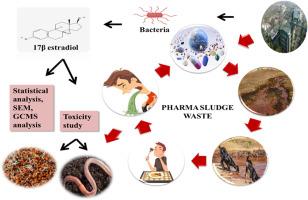Improved biodegradation of 17β-estradiol by indigenous microorganisms and assessment of its ecotoxicity
IF 3.5
3区 医学
Q3 IMMUNOLOGY
引用次数: 0
Abstract
Estrogen is a steroid hormone that damages aquatic animal ecology and human health because it contains two hydroxyl groups in its structure. Additionally, the environment is impacted by even a tiny ng/L. This study aims to isolate the organisms from drug-contaminated soil and to degrade 17β-estradiol from the environment. The isolated strains selected for degradation purposes were VITVK1, VITVK2, and VITVK3. The three strains were identified as rod-shaped bacteria the strains are Bacillus infantis, Achromobacter xyloxidans, and Sphingomonas sp. The genebank accession number was Bacillus infantis - PQ144088, Achromobacter xyloxidans - PQ155434, and Sphingomonas sp. - PQ144536. These strains are crucial to the current investigation; with Achromobacter xyloxidans achieving the highest degradation percentage of 17β-estradiol at 84 %, Sphingomonas sp. achieving 72 %, and Bacillus infantis achieving the lowest at 54 %. The maximum degraded bacteria sample was processed for optimization studies and analysed for SEM it was identified that degradation shows the changes in cell surface or the creation of extracellular materials are responsible for the degradation process of Achromobacter xylosoxidans, and GC-MS predicts the peak reduction of 0th hr-12th hr. Helminth toxicity of Eisenia fetida and phytotoxicity of Eleusine coracana of 17β-estradiol shows high toxicity in the untreated sample. The study emphasizes how indigenous microbes can be used to bioremediate areas contaminated with 17β-estradiol and help degrade the endocrine-disrupting chemicals.

本地微生物对17β-雌二醇的生物降解及生态毒性评价。
雌激素是一种类固醇激素,由于其结构中含有两个羟基,对水生动物生态和人类健康造成危害。此外,即使是很小的ng/L也会对环境产生影响。本研究旨在从药物污染的土壤中分离微生物,并从环境中降解17β-雌二醇。分离菌株分别为VITVK1、VITVK2和VITVK3。3株菌株鉴定为杆状细菌,菌株分别为婴儿芽孢杆菌、xyloxidachromobacter和鞘单胞菌sp.。基因库登录号为:婴儿芽孢杆菌- PQ144088、xyloxidachromobacter - PQ155434和鞘单胞菌sp. - PQ144536。这些菌株对目前的调查至关重要;其中木氧无色杆菌对17β-雌二醇的降解率最高,为84%,鞘氨单胞菌为72%,婴儿芽孢杆菌最低,为54%。对最大降解菌样品进行了优化研究和扫描电镜分析,发现降解表明细胞表面的变化或细胞外物质的产生是木氧化无色杆菌降解过程的原因,GC-MS预测第0 -12小时的峰值降低。17β-雌二醇在未处理的样品中显示出高毒性,对臭Eisenia fetida的蠕虫毒性和对coracana的植物毒性。该研究强调了如何利用本地微生物对被17β-雌二醇污染的区域进行生物修复,并帮助降解干扰内分泌的化学物质。
本文章由计算机程序翻译,如有差异,请以英文原文为准。
求助全文
约1分钟内获得全文
求助全文
来源期刊

Microbial pathogenesis
医学-免疫学
CiteScore
7.40
自引率
2.60%
发文量
472
审稿时长
56 days
期刊介绍:
Microbial Pathogenesis publishes original contributions and reviews about the molecular and cellular mechanisms of infectious diseases. It covers microbiology, host-pathogen interaction and immunology related to infectious agents, including bacteria, fungi, viruses and protozoa. It also accepts papers in the field of clinical microbiology, with the exception of case reports.
Research Areas Include:
-Pathogenesis
-Virulence factors
-Host susceptibility or resistance
-Immune mechanisms
-Identification, cloning and sequencing of relevant genes
-Genetic studies
-Viruses, prokaryotic organisms and protozoa
-Microbiota
-Systems biology related to infectious diseases
-Targets for vaccine design (pre-clinical studies)
 求助内容:
求助内容: 应助结果提醒方式:
应助结果提醒方式:


